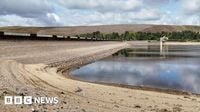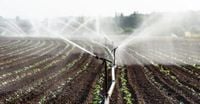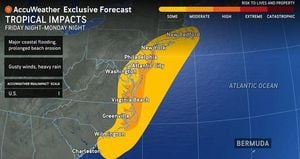Scotland, a country often synonymous with rain-soaked hills and lush, green landscapes, is facing an unprecedented water crisis. On August 25, 2025, the Scottish Environmental Protection Agency (SEPA) imposed the first water restrictions of the year in response to what officials are calling the most severe drought on record for the country’s east coast. The Ythan and North Fife catchment areas have reached “significant scarcity,” SEPA’s highest level of water scarcity, after more than 30 days of critically low river levels, according to BBC and STV News.
For months, Scotland’s east has endured a relentless dry spell. Every single month of 2025 has been drier than average, with some regions experiencing a rainfall deficit stretching as far back as June 2024. In fact, rainfall has been about 40% lower than the long-term average in certain areas, leaving rivers, soils, and groundwater under mounting pressure. “The water environment in parts of Scotland is clearly under stress and protecting it remains a top priority,” said Chris Dailly, SEPA’s head of environmental performance (geographic), as reported by STV News. “We recognise the challenges that farmers and other businesses face, but no one should be caught off guard – we’ve been speaking directly to licence holders across the summer. If you abstract water you should already have plans in place to reduce volumes, stagger abstractions and follow the conditions of your licence.”
The restrictions, which limit the amount of water that can be abstracted (the process of removing or diverting water from the natural environment via pumps and wells), primarily affect farmers and businesses. These temporary measures are designed to safeguard the environment, wildlife, and the communities that depend on healthy rivers. SEPA has made it clear that these restrictions will be lifted as soon as conditions permit, but the urgency is palpable. Other rivers along the east coast, including the Deveron and Don, are teetering on the brink of significant scarcity and could face similar restrictions in the coming days if the dry weather persists.
The impact of this drought is visible across the Scottish landscape. According to BBC, Backwater Reservoir near Glenisla in Angus—responsible for supplying drinking water to 300,000 people in and around Dundee—is now less than half full. The average reservoir levels in eastern Scotland last week were at just 56%, a stark contrast to the usual 81% for this time of year. Even in the west, where rainfall is more abundant, levels have dipped to 70% from the typical late-summer average of 82%.
As the nation basked in late summer sun this August, water demand soared by 100 million litres a day, jumping from 1,850 million litres to 1,950 million litres daily. Scottish Water, the publicly owned utility, is considering setting up a temporary network of pipes and pumps to move water from the River Isla into the Backwater Reservoir—a move that would require SEPA’s approval due to potential environmental impacts. Brian McCarthy, economic demand manager at Scottish Water, voiced his concerns: “If this extended dry period continues towards the autumn and winter, then that will be concerning for supplies going into next year and beyond.”
The drought’s effects are being felt not just in cities but also in rural communities. In the small town of Kirriemuir, the underground tank that supplies water from Backwater and Lintrathen reservoirs ran low last week and had to be topped up by tanker. Scottish Water has deployed a fleet of 25 lorries in recent weeks to shift supplies across the country, often moving water from the wetter west to the parched east. On the agricultural front, the challenges are even more acute. At Mairns of Cairnborrow farm near Huntly in Aberdeenshire, springs that provide drinking water for 240 cattle have run dry, forcing farmer Nicola Wordie to haul water by tank at least once, sometimes twice, daily. “We’re going up at least once if not twice a day to fill this cistern,” she explained to BBC, describing the urgent need to keep her livestock hydrated. “Last year it was wet for months on end and now it’s the total opposite and we’re dry for months on end. It’s the one extreme to the other. We are going to have to adapt.”
Experts warn that these extreme swings—known as “weather whiplash”—are becoming the new normal as climate change alters rainfall patterns in Scotland. Dr. Rebecca Wade, a senior lecturer in environmental science at Abertay University in Dundee, shed light on the underlying issues: “Our climate is changing which means that sometimes we have a lot less water than we’re used to having. Also, when we do get rainfall, it comes in a different pattern. So we might get a very intense short storm, and that could even cause localised flooding, but at the same time, it doesn’t resolve the drought situations because it’s not recharging the groundwater. It’s not filling up the reservoirs.”
Despite Scotland’s reputation for abundant water—boasting more than 30,000 freshwater lochs—Dr. Wade insists this perception is misleading. The Met Office notes that coasts of East Lothian, Fife, and the Moray Firth receive less than 700mm of rainfall annually, while the western Highlands can see over 4,000mm. With population growth projected to increase in the east, the pressure on already strained water resources is likely to intensify. “As our climate gets drier our industries and our agriculture are needing to draw on more water – so it exacerbates the situation. As we draw water from the natural environment it has a big impact on ecology and biodiversity,” Dr. Wade told BBC.
Scottish Water is urging residents to reduce consumption. In 2023/24, average daily water use per person was 178 litres in Scotland—significantly higher than the 140 litres per person in England and Wales. The utility is running a trial in Dundee involving water meters, aiming to encourage voluntary reductions by providing customers with more information about their usage. “Reducing usage would have a big impact on the sustainability of supplies for the future,” McCarthy explained.
There may be a glimmer of hope on the horizon. Heavy showers linked to the remnants of ex-Hurricane Erin are forecast to sweep across Scotland in the final week of August, potentially easing some of the restrictions. According to Met Office meteorologist Kathryn Chalk, “This band of rain... is going to be bringing in bands of showers or heavier spells of rain as we go through the week, and also some large waves especially across the western coast.” However, as Dr. Wade cautions, these short, intense storms may not be enough to restore reservoir levels or recharge groundwater in the long term.
The message from SEPA and Scottish Water is clear: adaptation is now essential. Whether through reducing personal consumption, investing in infrastructure, or shifting agricultural practices, Scotland must confront the reality that water—once considered limitless—has become a precious resource. The stakes are high for farmers, businesses, wildlife, and communities alike. As the country waits for the skies to open up, the hope is that this crisis will serve as a wake-up call, prompting lasting changes in how Scotland manages its most vital asset.






